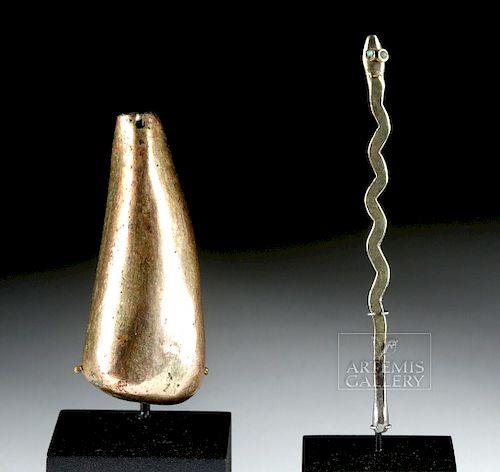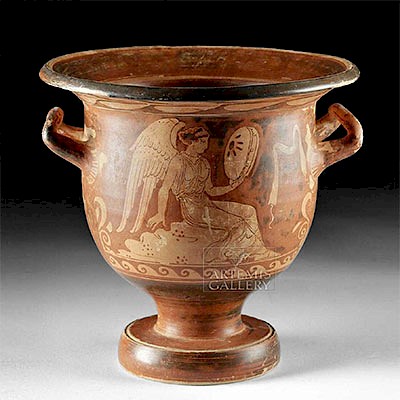Moche Gold & Silver Spoon, Gilded Copper Poporo, 49.4 g
Lot 181a
About Seller
Artemis Fine Arts
686 S Taylor Ave, Ste 106
Louisville, CO 80027
United States
Selling antiquities, ancient and ethnographic art online since 1993, Artemis Gallery specializes in Classical Antiquities (Egyptian, Greek, Roman, Near Eastern), Asian, Pre-Columbian, African / Tribal / Oceanographic art. Our extensive inventory includes pottery, stone, metal, wood, glass and textil...Read more
Estimate:
$4,500 - $6,500
Absentee vs Live bid
Two ways to bid:
- Leave a max absentee bid and the platform will bid on your behalf up to your maximum bid during the live auction.
- Bid live during the auction and your bids will be submitted real-time to the auctioneer.
Bid Increments
| Price | Bid Increment |
|---|---|
| $0 | $25 |
| $300 | $50 |
| $1,000 | $100 |
| $2,000 | $250 |
| $5,000 | $500 |
| $10,000 | $1,000 |
| $20,000 | $2,500 |
| $50,000 | $5,000 |
| $100,000 | $10,000 |
| $200,000 | $20,000 |
About Auction
By Artemis Fine Arts
Mar 7, 2019
Set Reminder
2019-03-07 10:00:00
2019-03-07 10:00:00
America/New_York
Bidsquare
Bidsquare : VARIETY SALE | Antiquities & Ethnographic Art
https://www.bidsquare.com/auctions/artemis-gallery/variety-sale-antiquities-ethnographic-art-3928
Around the world & back in time - be amazed at the treasures you will find. Antiquities from Egypt, Greece, Italy and the Near East, Asian, Pre-Columbian, African / Tribal / Oceanic, Native American, Spanish Colonial, Russian Icons, Fine Art, much more! Artemis Fine Arts info@artemisfinearts.com
Around the world & back in time - be amazed at the treasures you will find. Antiquities from Egypt, Greece, Italy and the Near East, Asian, Pre-Columbian, African / Tribal / Oceanic, Native American, Spanish Colonial, Russian Icons, Fine Art, much more! Artemis Fine Arts info@artemisfinearts.com
- Lot Description
Pre-Columbian, North Coast Peru, Moche, Loma Negra, ca. 300 to 100 BCE. A fine gathering of two intriguing pieces from ancient Peru. First is a slender spoon, comprised of 64% gold (equivalent to 15K+ gold) on one side and silver (30%) on the other, depicting a slithering snake with a thick tail which doubles as the scoop, a sinuous body, and a conical head with inlaid turquoise eyes. Second is a heavy copper poporo of a round-bottomed, teardrop-shaped form covered in a layer of gilding with a large interior cavity for holding lime powder. Custom museum-quality display stands included. Size (snake): 3.75" H (9.5 cm); 5.625" H (14.3 cm) on included custom stand; quality of gold: 64% (equivalent to 15K+); quality of silver: 30%; total weight: 6.7 grams. Size (poporo): 1.7" W x 2.8" H (4.3 cm x 7.1 cm); 4.7" H (11.9 cm) on included custom stand; quality of gold: 25%; total weight: 42.7 grams.
Poporos or lime containers were part of the ancients' coca-chewing implements. They were made from various materials - including shell, stone, wood, bone, ceramic, and gold - throughout the Andes of South America for thousands of years. Traditionally, the indigenous chewed coca by placing some leaves in the cheek and gradually adding powdered lime made from calcined shells from the poporo with a spoon like this example in order to enhance the stimulating effect. A poporo consists of two pieces: the receptacle and the lid which includes a pin that is used to carry the lime to the mouth while chewing coca leaves; this example does not include a lid. Since the chewing of coca is sacred for the indigenous people, poporos are also attributed with mystical powers and social status.
It should be said that any goldwork from the Moche is exceedingly rare, as their treasures were targeted by plunderers during Colonial times. Heidi King of the Metropolitan Museum of Art in New York offers the following explanation in "The Art of Precolumbian Gold": "The Mochica or Moche as they are also known, built their capital in the dry, coastal valley of Moche, where the main construction was the Huaca del Sol, the so-called Pyramid of the Sun, the largest adobe structure built in Pre-Columbian South America. The great pyramid, made of over 143 million adobe bricks, was clearly visible and easily accessible during Colonial times, and it received extraordinary attentions from early treasure hunters (Bray this volume). As a result of such attentions, little of the wealth in precious metals that the Moche peoples are believed to have possessed remains in its ancient form today. Those works that do remain are all the more important because of their rarity." (The Art of Precolumbian Gold: The Jan Mitchell Collection" edited by Julie Jones. Boston: Little Brown & Company, 1985, p. 212)
Provenance: private Hawaii, USA collection; ex-Fred Leighton & Alexander Alcevedo collection, New York, New York, USA
All items legal to buy/sell under U.S. Statute covering cultural patrimony Code 2600, CHAPTER 14, and are guaranteed to be as described or your money back.
A Certificate of Authenticity will accompany all winning bids.
We ship worldwide and handle all shipping in-house for your convenience.
#144340Both items have slight bending to overall forms, and minor abrasions, otherwise intact and excellent. Nice patina and light earthen deposits throughout.Condition
- Shipping Info
-
All shipping is handled in-house for your convenience. Your invoice from Artemis Gallery will include shipping calculation instructions. If in doubt, please inquire BEFORE bidding for estimated shipping costs for individual items.
-
- Buyer's Premium



 EUR
EUR CAD
CAD AUD
AUD GBP
GBP MXN
MXN HKD
HKD CNY
CNY MYR
MYR SEK
SEK SGD
SGD CHF
CHF THB
THB














